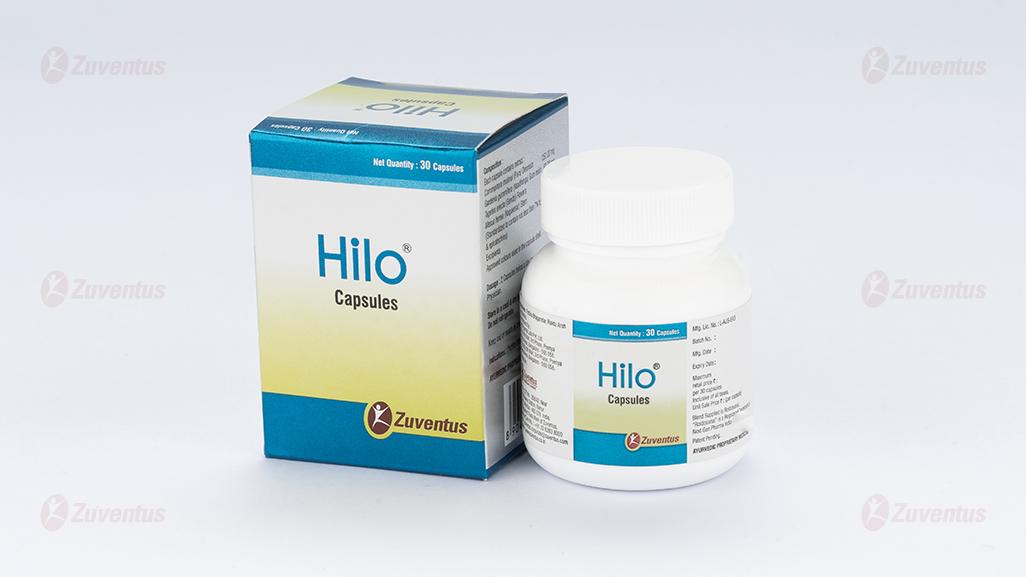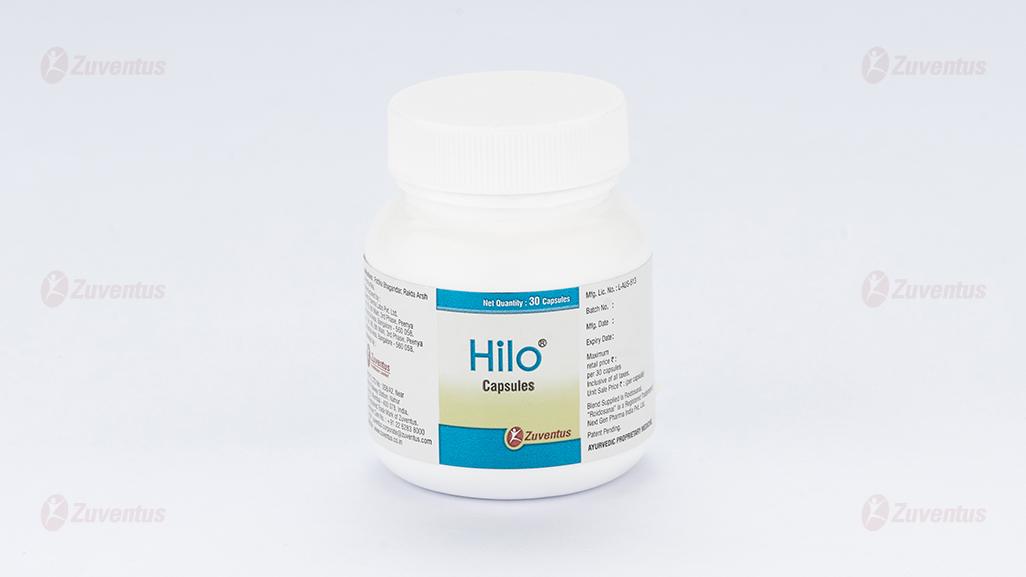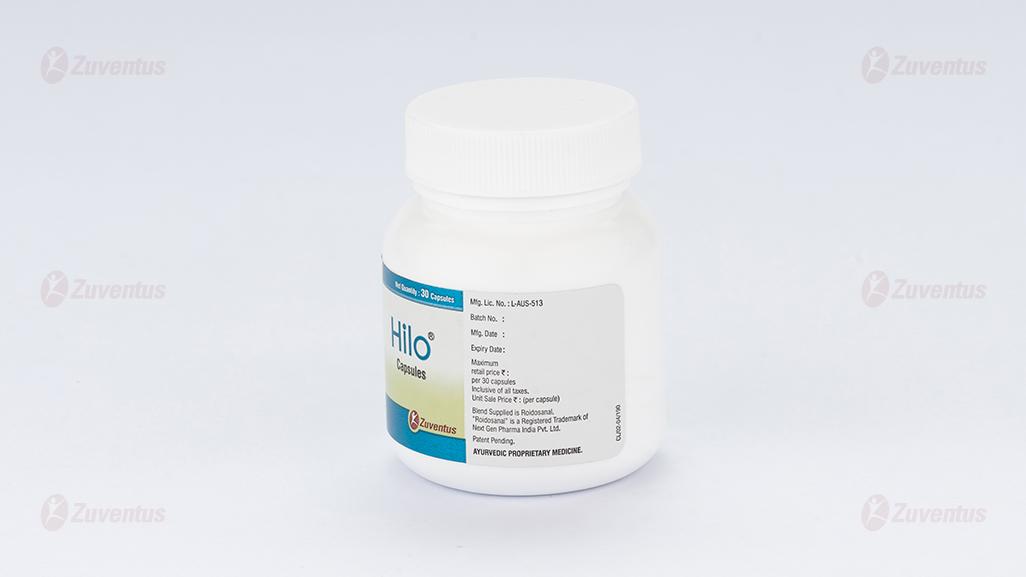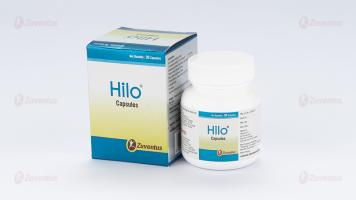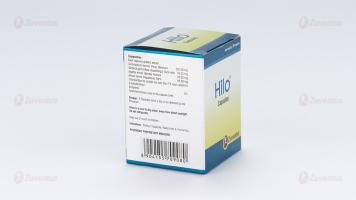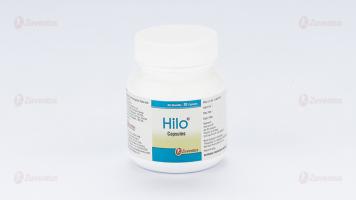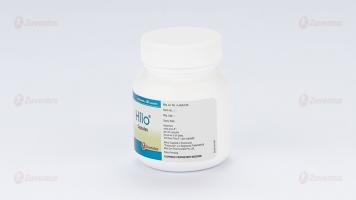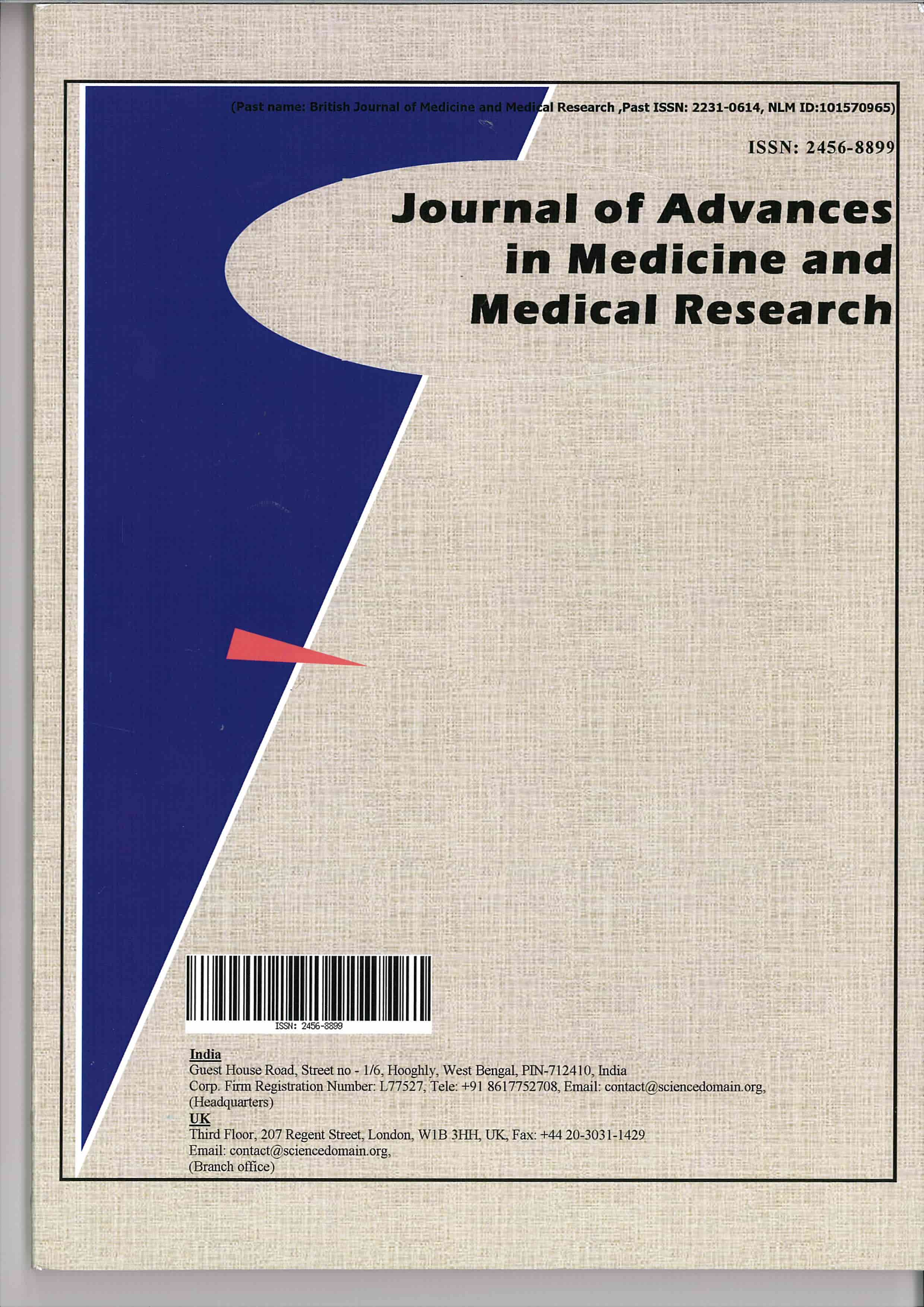Hilo Capsules
Therapy Area
Hemorrhoid Medications
1.0 Generic name
Commiphora molmol (Pura) Oleoresin, Gardenia gummifera (Naadihingu) Gum resin, Tagates erecta (Genda) Flowers, Mesua ferrea (Nagakesar)
2.0 Qualitative and quantitative composition
Each Capsules contains extract
Commiphora molmol (Pura) Oleoresin 250 mg
Gardenia gummifera (Naadihingu) Gum resin 83 mg
Tagates erecta (Genda) Flowers 83.5 mg
Mesua ferrea (Nagakesar) Stem 83.5 mg
(Standardized to contain not less than 7% catechins and epicatechins)
3.0 Dosage form and strength
Capsule, 500mg
4.0 Clinical particulars
4.1 Therapeutic Indication
For the treatment of hemorrhoids (piles) and anal fissure.
4.2 Posology and method of administration
2 capsules twice a day for 15 days or as directed by the Physician
Method of administration: Oral
4.3 Contraindications
- Hypersensitivity to the active substances or to any of the excipients
- Catechins decrease platelet aggregation and hence when patient is on drugs like aspirin which also decrease platelet aggregation caution should be administered
4.4 Special warnings and precautions for use
- Recommended not to be taken by pregnant women, lactating mothers and children below 8 years unless taken under medical supervision
- Do not exceed the recommended dosage
- Strictly adhere to product directions to achieve maximum benefits of Hilo
- Avoid spicy food and salt intake
- Please keep this product out of reach of children
4.5 Drugs interactions
- Catechins decrease platelet aggregation and hence when patient is on drugs like aspirin which also decrease platelet aggregation, caution should be administered.
- Green tea catechin supplementation should be stopped before any surgical procedure.
4.6 Use in special populations
No known data on special population.
4.7 Effects on ability to drive and use machines
No studies on the effects on the ability to drive and use machines have been performed.
4.8 Undesirable effects
Some cases of routine gastric disorders and neurovegetative disorders (feeling of discomfort) have been reported, not requiring discontinuation of treatment.
4.9 Overdose
No cases of overdose have been reported.
5.0 Pharmacological properties
5.1 Mechanism of Action
Hemorrhoids are defined as the symptomatic enlargement and distal displacement of the normal anal cushions.
The most common symptom of hemorrhoids is rectal bleeding associated with bowel movement. The abnormal dilatation and distortion of the vascular channel, together with destructive changes in the supporting connective tissue within the anal cushion, is a paramount finding of hemorrhoids. The dysregulation of the vascular tone and vascular hyperplasia might play an important role in hemorrhoidal development.
Hilo is a venotonic drug and a vascular-protecting agent. The efficacy of Hilo is accounted for by its specific action on the principal elements of venous disease.
Venotonic: Hilo reinforces venous tone, decreases venous capacitance, venous distensibility and venous emptying time.
Vascular-protecting agent: Hilo protects the microcirculation by fighting the microcirculation-damaging process; it combats venous inflammation by decreasing leukocyte activation, and as a consequence, by inhibiting the release of inflammatory mediators (Cytokines, IL 1-β & TNFα), principally free radicals (5-LOX, ROS & RNS) and prostaglandins. Thus, Hilo normalizes capillary permeability and strengthens capillary resistance.
Hilo acts on the lymphatic system: It improves lymphatic drainage by increasing lymph flow and lymph oncotic pressure. This action on the lymphatic system associated with a venotonic and vasculoprotective effect, explains the activity of Hilo on edema.
By virtue of its venotonic, vascular-protecting and anti-inflammatory action, Hilo improves hemorrhoidal symptoms and signs e.g., anal discomfort, pain, redness, anal discharge, tenesmus, pruritus, erythema and bleeding. It also significantly reduces the frequency, severity and duration of acute hemorrhoidal attacks and bleeding by chronic treatment in all grades of haemorrhoids.
5.2 Pharmacodynamic properties
Commiphora molmol (Pura)
Several studies revealed that the resinous exudates of different Commiphora tree species produced analgesic and anti-inflammatory, antiulcer, antioxidant, anti-hyperlipidemic, hypoglycemic, and cardioprotective effects. The resinous exudates of different Commiphora tree species have been used for arthritis, hyperlipidemia, and pain, inflammatory conditions, healing of wounds, obesity, schistosomiasis, and gastrointestinal diseases.
In Ayurvedic medicine, myrrh has long been used to treat problems associated with the mouth, such as gingivitis, mouth ulcers, and pharyngitis (sore throat). In modern Chinese medicine, myrrh is used for improving blood circulation; treating traumatic injuries; incised wounds; bone, tendon, and ligament pain; amenorrhea; and hemorrhoids or other painful swellings.
Externally, myrrh has been used for hemorrhoids and wounds. Myrrh has astringent properties that help bind skin to create a barrier against infection.
Gardenia gummifera (Naadihingu)
Nadihingu is pungent in taste, pungent in the post digestive effect and has hot potency. It alleviates kapha and vata doshas. It possesses light, dry and sharp attributes. It facilitates the vata through intestines and helps to remove the obstruction and constipation. It is useful in flatulence and constipation.
The dried resin of the plant Gardenia gummifera is dissolved in water and given to patients suffering from intestinal worms, distention of abdomen, constipation and piles.
Tagates erecta (Genda Flowers)
In traditional and homeopathic medicine flower leaves has been used for skin complaints, wounds and burns, conjunctivitis and poor eyesight, menstrual irregularities, varicose veins, hemorrhoids, duodenal ulcers, etc. The flowers are especially employed as a remedy for bleeding piles and said to purify blood. Lutein is an oxycarotenoid or xanthophyll. It is one of the major constituents and the main pigment of Tagetes erecta.
Mesua ferrea (Nagakesar)
Stem It possesses various pharmacological constituents like 4-phenyl cumarin analogues, oleic acid, stearic acid, palmitic acid, B-sitosterol, two new bioflavonoids and lupeol type of triterpenoid.
Ayurvedic Properties: Powder of Nagakesara (stamens of flowers of Mesua ferrea Linn.), butter (navanita) and sugar (sarkara) are mixed and orally given to patients of bleeding piles or haemorrhoids (raktarsa) as well as dysentery with mucus.
Piles (Arsh) are vascular structures in the anal canal which gets swollen and inflamed and the patient feels difficult to defecate with continuous throbbing (pin pricking ) pain along with bleeding stools, Nagkesar reduces the Swelling and Shrinks the Piles, Eradicating the Pain and Stops the Bleeding.
Catechins & Epicatechins
[Oligomeric Proanthocyanidins]
Hilo is a processed and standardized herbal preparation containing catechins & epicatechins, which are the monomers of naturally occurring proanthocyanidins.
Mechanism of action of Flavonoids i.e.Oligomeric proanthocyanidins (OPC)
- OPCs crosslink the collagen fibers in the vessel basement membranes which make them stronger and less permeable
- The proanthocyanidins or monomeric catechins increase plasma antioxidant activity and also show beneficial effects on capillary fragility & permeability
- Inhibition of enzymes hyaluronidase, elastase and collagenase which degrade the connective tissue leading to increased capillary permeability
- OPCs prevent the release and synthesis of compounds associated with inflammation and allergies such as histamine, serine proteases, prostaglandins and leukotrienes.
- Carry vitamin C to the basement membranes which leads to increased production of collagen making vessels (veins) strong
It has been observed that oligomeric proanthocyanidins are about 20 times more effective at trapping oxygen radicals than some of the commonly used bioflavonoids. By exhibiting strong antioxidant and vasculoprotective activity, Hilo brings relief to patients with hemorrhoids and/or anal fissures.
5.3 Pharmacokinetic properties
No known pharmacokinetics data.
6.0 Nonclinical properties
6.1 Animal Toxicology or Pharmacology
Acute oral toxicity study was conducted in Sprague Dawley Rats (Including both sexes 10 male & 10 non-pregnant female, 6 to 8 weeks age, 5 males & 5 females each randomly assigned in drug treated group and in control group, randomly assigned). No sign of intoxication was observed in animals treated at the dose level of 2000mg/kg of the test substance. All animals survived through the study period of 14 days. The rats were deprived of feed for 16 hours before and 3 hours after the administration of the test substance. The test substance, suspended in 0.1% aqueous carboxy methyl cellulose was administered once by oral route to rats.
It was concluded that acute lethal oral dose in Sprague Dawley Rats was found to be greater than 2000 mg/kg body weight.
7.0 Description
Commiphora molmol is small perennial tropical trees that grown in arid and semiarid regions in East Africa, Saudi Arabia, and India. Myrrh is a resinous exudate (oleo-gum resin) obtained from the stem of C. molmol trees. Myrrh has been approved by USFDA as a safe natural flavoring agent in foods and beverages and as fragrance in cosmetics. For many years, myrrh (oleo-gum resin) has been used for healing wound injuries.
Nadi hingu- Gardenia gummifera is an herb mentioned in the ayurvedic pharmacopoeia for the treatment of fever, digestive disorders, dental problems during eruption, wounds, skin diseases and pain in abdomen due to intestinal worm or constipation. The plant grows all over India, in deciduous forests, especially in Maharashtra, Gujarat, Bihar and South India.
Tagetes erecta, popularly known as marigold, is grown as an ornamental plant. Flowers of this plant are used loose or in garlands for social and religious purposes in Eastern countries (India).
Nagakesara (Mesua ferrea Linn.) has its special place in Ayurveda as the drug is useful for multi system disorders and this drug happens to be most consumed drug by domestic industries in volumes (million tons) after Amalaki and Hareetaki.
Catechins & epicatechins belong to the class of flavonoids. When the number of connected catechins is 10 or less they are called oligomers and thus the term used is "Oligomeric Proanthocyanidins." (OPC).
8.0 Pharmaceutical particulars
8.1 Incompatibilities
None stated
8.2 Shelf-life
Refer on pack
8.3 Packaging information
30 capsule/bottle
8.4 Storage and handing instructions
Store in cool and dry place away from direct sunlight. Do not refrigerate.
Keep out of reach of children.
9.0 Patient Counselling Information
- Do not exceed the recommended dosage
- Read the label carefully before use
- Keep at least half an hour gap between food/drink/ any other medicines and allopathic medicine
- Report any untoward or undesirable effect which has not been mentioned in this package insert to your doctor.
12.0 Date of Revision
13-06-2024
About Leaflet
Read all of this leaflet carefully before you start taking this medicine. It contains important information for your treatment.
If you have any further questions, if you are in any doubt, ask your doctor, health care provider or pharmacist for more information.
- Keep this leaflet. You may need to read it again.
- Ask your pharmacist if you need more information or advice.
- If the symptoms get worse or persist, consult a doctor or health care provider.
- If any of the side effects gets serious, or if you notice any side effects not listed in this leaflet, please tell your doctor, health care provider or pharmacist.
In this leaflet:
- What Hilo® Capsules is and what it is used for
- Before you take Hilo® Capsules
- How to take Hilo® Capsules
- Possible side effects
- How to store Hilo® Capsules
- Further information
1. What Hilo® Capsules is and what it is used for
Hilo capsule is a processed herbal preparation formulated as a 500 mg capsule and is standardized to contain not less than 7% of catechins and epicatechins. It offers rapid relief from hemorrhoids and effective in treating both internal and external piles. Hilo consist of following components:
Commiphora molmol (Pura)
Several studies revealed that the resinous exudates of different Commiphora tree species produced analgesic and anti-inflammatory, antiulcer, antioxidant, anti-hyperlipidemic, hypoglycemic, and cardioprotective effects. The resinous exudates of different Commiphora tree species have been used for arthritis, hyperlipidemia, and pain, inflammatory conditions, healing of wounds, obesity, schistosomiasis, and gastrointestinal diseases.
In Ayurvedic medicine, myrrh has long been used to treat problems associated with the mouth, such as gingivitis, mouth ulcers, and pharyngitis (sore throat). In modern Chinese medicine, myrrh is used for improving blood circulation; treating traumatic injuries; incised wounds; bone, tendon, and ligament pain; amenorrhea; and hemorrhoids or other painful swellings.
Externally, myrrh has been used for hemorrhoids and wounds. Myrrh has astringent properties that help bind skin to create a barrier against infection.
Gardenia gummifera (Naadihingu)
Nadihingu is pungent in taste, pungent in the post digestive effect and has hot potency. It alleviates kapha and vata doshas. It possesses light, dry and sharp attributes. It facilitates the vata through intestines and helps to remove the obstruction and constipation.
It is useful in flatulence and constipation. The dried resin of the plant Gardenia gummifera is dissolved in water and given to patients suffering from intestinal worms, distention of abdomen, constipation and piles.
Tagates erecta (Genda Flowers)
In traditional and homeopathic medicine flower leaves has been used for skin complaints, wounds and burns, conjunctivitis and poor eyesight, menstrual irregularities, varicose veins, hemorrhoids, duodenal ulcers, etc. The flowers are especially employed as a remedy for bleeding piles and said to purify blood. Lutein is an oxycarotenoid or xanthophyll. It is one of the major constituents and the main pigment of Tagetes erecta.
Mesua ferrea (Nagakesar) Stem
It possesses various pharmacological constituents like 4-phenyl cumarin analogues, oleic acid, stearic acid, palmitic acid, B-sitosterol, two new bioflavonoids and lupeol type of triterpenoid.
Ayurvedic Properties: Powder of Nagakesara (stamens of flowers of Mesua ferrea Linn.), butter (navanita) and sugar (sarkara) are mixed and orally given to patients of bleeding piles or haemorrhoids (raktarsa) as well as dysentery with mucus.
Piles (Arsh) are vascular structures in the anal canal which gets swollen and inflamed and the patient feels difficult to defecate with continuous throbbing (pin pricking ) pain along with bleeding stools, Nagkesar reduces the Swelling and Shrinks the Piles, Eradicating the Pain and Stops the Bleeding.
Hilo Capsule promotes the reduction of hemorrhoid size and enhances bowel movements. Its venotonic (it increases venous tone), vascular-protective (it increases resistance in small blood vessels)., and anti-inflammatory qualities relieve symptoms like bleeding, anal discomfort, pain, redness, discharge, tenesmus, itching, and erythema, with hemorrhoids. Regular use of Hilo significantly decreases the frequency, severity, and duration of acute haemorrhoidal episodes and bleeding. It is also used for anal fissure treatment.
2. Before you take Hilo® Capsules
- Do not take Hilo® Capsules
- If you are allergic (hypersensitive) to flavonoids, catechins and epicatechins or any of the other ingredients.
- Take special care with Hilo® Capsules
- Haemorrhoidal attack: If the haemorrhoid disorder persists for more than 15 days, it is essential that you consult your doctor or health care provider.
- Taking or using other medicines, herbal or dietary supplements
- Tell your doctor, health care provider or pharmacist if you are taking or have recently taken any other medicines, including medicines obtained without a prescription.
- Taking Hilo® Capsules with food and drink
- Not applicable.
- Pregnancy and breastfeeding
- Pregnancy
- If you discover that you are pregnant during your treatment, or if you are pregnant and plan to take this medicine, ask your doctor or health care provider for advice. As a precautionary measure, it is preferable to avoid the use of Hilo® Capsules during pregnancy.
- Breast-feeding
- Breast-feeding is inadvisable for the duration of the treatment, due to the absence of data on the passage of the medicine into breast milk. Ask your doctor, health care provider or pharmacist for advice before taking any medicine.
- Pregnancy
- Driving and using machines
- Not applicable.
- Important information about some of the ingredients of Hilo® Capsules
- Not applicable.
3. How to take Hilo® Capsules
Always take Hilo® Capsules exactly as your doctor or health care provider has told you. You should check with your doctor, health care provider or pharmacist if you are not sure.
Dosage
2 Hilo capsules twice a day for 15 days or as directed by the Physician
Method of administration: Oral
- If you take more Hilo® Capsules than you should
- An overdose of this medicine can make side effects worse.
- If you take more Hilo® Capsules than you should, contact your doctor, health care provider or pharmacist.
- If you forget to take Hilo® Capsules
- Not applicable.
- If you stop taking Hilo® Capsules
- Not applicable.
4. Possible Side Effects
Like all medicines, Hilo® Capsules can cause side effects, although not everybody gets them. Some cases of commonplace gastrointestinal disorders and neurovegetative disorders (feeling of discomfort) have been described, which do not require stopping the treatment.
Reporting of side effects
If you get any side effects, talk to your doctor, pharmacist or nurse. This includes any possible side effects not listed in this leaflet. You can also report side effects directly:
Website: www.zuventus.co.in and click the tab “Safety Reporting” located on the top end of the home page. https://www.zuventus.co.in/drug-safety-reporting
By reporting side effects, you can help provide more information on the safety of this medicine. You can also report the side effect with the help of your treating physician.
5. How to store Hilo® Capsules
Keep out of the reach and sight of children. Store below 30°C. Store in the original carton. Do not use Hilo® Capsules after the expiry date which is stated on the box. The expiry date refers to the last day of that month.
Medicines should not be disposed of via wastewater or household waste. Ask your pharmacist how to dispose of medicines no longer required. These measures will help protect the environment.
6. Further Information
- What Hilo® Capsules contains
AYURVEDIC PROPRIETARY MEDICINE.
Each Capsules contains extract
Commiphora molmol (Pura) Oleoresin 250 mg
Gardenia gummifera (Naadihingu) Gum resin 83 mg
Tagates erecta (Genda) Flowers 83.5 mg
Mesua ferrea (Nagakesar) Stem 83.5 mg
(Standardized to contain not less than 7% catechins and epicatechins)
- What is Hilo® Capsules looks like and content of the pack
30 capsule/bottle (container)
- Marketing Authorisation Holder and Manufacturer
Zuventus Healthcare Ltd. Plot Y2, CTS No: 358/A2, Near Nahur Railway Station, Nahur (West), Mumbai, 400 078, India.
This leaflet was last revised in June 2024

